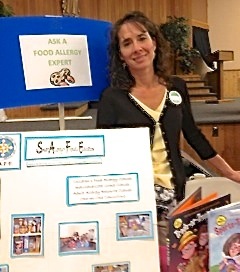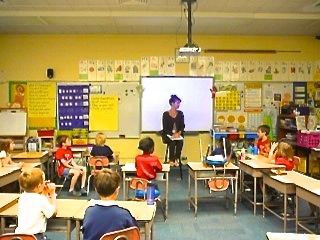< Back to Blog Posts
10 Tips for Talking to Your School About Food Allergies

By Daniella Knell
Sending your child with food allergies off to school can be overwhelming. Trusting others to keep your kid safe is probably your #1 priority! For me, educating myself and others was the only way I could create a safer learning environment for both my children and their caregivers.
As food allergy parents, we constantly wonder, “What if something happens?” In my opinion, a more productive question is, “Does the person taking care of my child know what to do if and when something happens?”
It is all about education.
That’s the key to making sure that your answer to the above question is, “Yes, my child is in good hands.” When people don’t understand food allergies, they don’t know how to protect people who have them. The first step is educating—educating yourself, educating your child, and educating others. This guide will help you educate those around you most effectively.
1. Attitude
To effectively educate others, you will need to partner with your school. Know that your attitude sets the tone. This will make or break how your school will or won’t work with you. If you go in with a steamroller approach with demands, you’re likely to meet resistance. Have you ever heard the saying, “you catch more flies with honey than vinegar?” Approach your school with a positive, understanding attitude and you are more likely to see positive, understanding results!
2. Resources
Find Educational Resources YOU Trust. You can direct others to these resources and use them to bolster your position. They will also help you remember that you aren’t alone! Here are links to some of my favorites.
- FAACT – Food Allergy & Anaphylaxis Connection Team FAACT is currently my favorite because I find them the easiest to navigate and LOVE their primary focus on education. Their School Curricula Program offers ready to share presentations for the classrooms, beginning with K thru 3.
- FARE – Food Allergy Research & Education FARE’s ‘Be A Pal: Protect a Life’ program spotlights Alexander the Elephant and his circle of food allergy friends. I still use portions of this program when presenting to preschool and early elementary school children.
- KFA – Kids with Food Allergies KFA has an entire page dedicated to keeping kids with food allergies safe at schools, including free guides and handouts!
3. FAAP
Find a Food Allergy Action Plan (FAAP) YOU Like. Your allergist fills out this form outlining actions to be taken by a caregiver in the instance your child has an allergic reaction while in their care. Here is one place you can start: Children’s Physician Network Food Allergy Action Plan
4. Management Plan
Figure out WHAT KIND of Management Plan Your Child Will Need. IHP? IEP? Or 504? If your child has life threatening food allergies, they may be considered as a qualified student with disabilities under the Americans with Disability Act (ACT) Amendments Act of 2008. Section 504 of the Rehabilitation ACT of 1973 requires that the school district to provide a “free and appropriate education” (FAPE). Then again, this will depend on whether they are attending a school receiving ANY federal funding, and laws can vary from state to state. DON’T be overwhelmed! Your allergist can help you out!
The following links will offer your more information regarding 504 Plans, IEPs and IHPs.
FAACT 504 Plans
FAACT Individualized Education Plans (IEPs)
FAACT Individualized Health Plans (IHPs)
5. Gather Resources
Find some books and videos you like. My favorites include: the ENTIRE No Biggie Bunch series, The Bugabees, The Princess and the Peanut, and the Alexander the Elephant Who Couldn’t Eat Peanuts – Gets a Babysitter
6. Create a School Food Allergy Binder
Put together useful resources and have a copy available to share with the nurse and teacher. I would also include some kind of handy labels you can use to mark ‘SAFE’ snacks or a snack box for your child. Any kind of label will work. Here’s an example of the ones I personally designed: S.A.F.E. Food Allergy Labels.
7. Flyers
Find samples of food allergy flyers on line which you like. Just type in ‘peanut free’, ‘allergy free’ pics in your favorite search engine and you will find ALL kinds of different flyers you can use. Have these different options available to share with school personnel.
8. Meet with People
Meet with the Principal. Meet with school nurse. Meet with your child’s teacher. This is your opportunity to meet with everyone and explain your concerns. Let the individuals know you’re wanting to partner with the school to create a SAFE and enjoyable learning environment for everyone. It will be at this time you will find out what previous experiences these individuals have had in managing food allergies. You may be pleasantly surprised. You may be disappointed. Most importantly, you will be prepared to decide what direction you need to go in moving forward with your school.
9. Have Your Child Meet with ALL of the People They Will Meet
This is the opportunity to show your child all the individuals around them whom are working to keep them SAFE. Don’t underestimate the NEED for your child to need to feel this comfort. They don’t WANT to feel singled out, but they also need to feel SAFE.
10. Get Involved!
In the beginning it may be nerve racking, but you can do it. Set up a time to go in and read stories, show a video, whatever it is you want to do to make learning about food allergies FUN!
Daniella Knell, owner of Smart Allergy~Friendly Education, is mother to two children with food allergies. You can find her displaying her public speaking skills in local schools and hospitals, blogging, and presenting allergy~friendly smoothie videos. For allergy~friendly ideas for your household, visit Daniella’s website, Facebook, LinkedIn and Twitter.





Make It With
SunButter






Make It With SunButter





